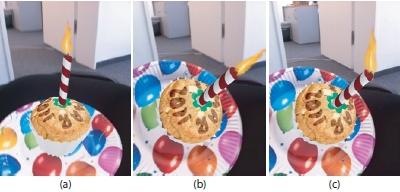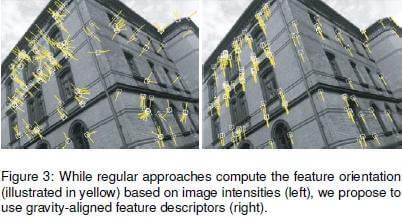
Augmented reality allows you to look through the camera on your mobile phone and see a digital world superimposed on the real one. Metaio allows augmented reality to actually understand the physical world. The Munich-based firm is one of the biggest names in AR, and Metaio recently made several exciting announcements. Top among them: their mobile AR technology now understands gravity, has high-end 3D object recognition, places 3D objects nearly flawlessly on your screen, and each of these improvements are now going to be available to every mobile developer for free later this year. Consumers will enjoy the tech by using Junaio, Metaio’s mobile AR browser. Watch the new advancements in AR technology in the videos below. Metaio wants augmented reality on every smart phone by 2014. Their latest improvements not only make AR better for users, it may attract the interest needed to make augmented reality a mobile industry standard.
Why teach augmented reality about gravity? I spoke with Trak Lord from Metaio’s San Francisco office about the newest improvements to their mobile AR technology. Modern smart phones come with a bevy of inertial sensors that typically are used for things like a compass function, but which Metaio can use (along with some complex algorithms) to detect which way gravity is pulling. Knowing about gravity allows Metaio’s AR to align everything it sees with a constant direction in the real world. It’s like giving the technology a whole new sense through which to experience its surroundings. That added sense makes Metaio’s newest AR faster, more accurate, and more realistic. In the following video the Gravity Aligned Feature Description (GAFD) tech is used to improve the speed at which objects appear on screen under various difficult conditions (such as oblique angles). Make sure to catch how GAFD allows for a flawless placement even as a marker is obscured (0:48), and teaches a digital flame the right way to burn (0:60).
The recently completed International Symposium for Mixed and Augmented Reality (ISMAR 2011) provided a great place to measure Metaio’s 3D object recognition skills. They entered Junaio into the annual tracking competition and took first prize – reportedly the first time 3D tracking was demonstrated in a mobile commercial application. Combining markerless recognition with sensor readings from the mobile device and simultaneous learning and map acquisition (SLAM), Junaio was able to understand the 3D environment in real-time. The videos from ISMAR aren’t terribly excitingly. Luckily, Metaio had previously showcased their “augmented city” – a prototype look at advanced 3D object recognition and placement in real world environments. Well, there’s nothing prototype-like about that technology anymore. Junaio’s 3D skills are now gearing up for prime time. Here’s another look at the crisp and quick 3D objects seen in the augmented city demo. With skills like this, the victory at ISMAR makes a lot of sense:
Lord says that the R&D side of Metaio (which, incidentally constitutes about half the company) has been getting a lot of use out of the Kinect 3D sensor. In the following video, a quick pass with the RGB detection of the Kinect enables Metaio to show off some of their latest improvements in augmented reality. Notice how rapidly shaking the viewing device doesn’t faze the digital object being viewed in the newly scanned environment (0:28). When a new object is added to the scene, Metaio can make the digital image appear behind it – just like it would in real life (0:39). The meshing of 3D objects into physical 3D surroundings is also wonderfully accurate (1:03):
As the videos above have shown, augmented reality has come a long way in the last five years. Whereas early versions of the tech always required special markers (like QR codes) to place objects, Metaio’s AR mostly doesn’t need them. When a hand passed in front of the camera it used to lead to digital objects disappearing for a short time. Now it hardly even matters. Alignment was buggy, now it’s accurate in three dimensions. On top of all that, Metaio’s gravity sensing gives digital objects an entirely new variable to play with – something that can be used to make animations more realistic or simply faster. At every turn, AR is clearly improving.

Yet if these augmented reality demos were the first you ever saw, you might think: “well yeah, that’s exactly how this technology should work, what’s the big deal?” Lord discussed how, partly with Metaio’s latest improvements, mobile AR has finally arrived to the point were it’s as accurate and fast as users’ expectations demand. It’s always been an impressive and fun technology, but AR is just now maturing to the point where it may be able to transition from “cool” to “extraordinarily helpful to the common person.”
Of course, Metaio can’t take credit for that on their own. There are many other companies out there pushing the capabilities of augmented reality, especially in Europe and Asia where it’s vastly more popular than in the US. What Metaio may be better at, and what Lord states is a major goal of the company, is to mature the third party development community alongside the maturing basic AR technology. The accuracy is there, the hardware is finally becoming capable of handling higher end graphics, everything’s getting cheaper – it’s now time for the great content to arrive.
Singularity Hub recently reviewed Metaio’s launch of their Junaio AR browser. The latest version of Junaio allows you to simply look through your phone and quickly choose between third party augmented reality apps. No matter which developer made the AR images you want to see, you can find them all through the same interface. That’s a great approach that’s been successful with other companies in the past. With 1.7 million downloads and 5000+ developers, Junaio is also a great platform to bring that innovation to the masses. It’s probably safe to say that Junaio is the portal through which we’ll see much of the new AR content Metaio hopes to engender. But it’s not Metaio’s only tactic in generating that content. Lord says that by the end of Q4 2011, the Metaio Mobile SDK (including the features we saw in the video above) will be available to all developers for free. That’s thousands of dollars worth of software (and it comes fully supported). There’s certainly no guarantee that such a bargain will attract hordes of new developers, but it certainly won’t hurt.
Metaio’s latest announcements then, may comprise a one-two punch from the company. Innovations in the basic AR tech allows for a quality of experience that users will enjoy on Junaio, while removing financial barriers should pull in developers to create content. In the end, Metaio’s not really in the business of making augmented reality apps, they’re in the business of making AR apps better. If they, and their international competitors, continue on this steady trend of innovation we may well see augmented reality on every smart phone by 2014. More importantly, we may see that technology become one of the basic uses of mobile devices.
Are you reaching into your pocket to make a phone call, browse the web, or seamlessly merge the digital and physical worlds?
[image and video credits: Metaio]
[source: Metaio]



